Mature Older Woman Cougar Poryrait Non Nude Fully Dressed
'Disarmingly intimate' photos of women
(Image credit:
Susan Meiselas / Magnum Photos
)
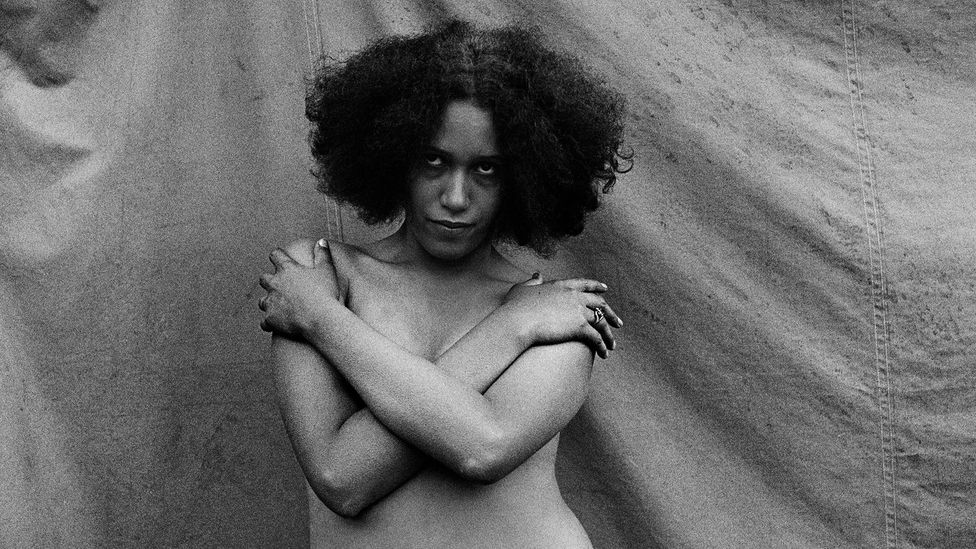
An exhibition at the Rencontres d'Arles festival features work by three female photographers who each capture revealing and rarely seen images of women.
T
The US photographer Susan Meiselas first began shooting women who took their clothes off for a living in 1972, when she was in her mid-20s. Travelling around New England, she'd encountered the country fairs that toured rural parts of the northeastern US; many had a 'girl show' tent, where women danced in striptease acts. Meiselas was fascinated. Over the course of three summers, she haunted the fairgrounds, befriending dancers and sneaking backstage to capture what their lives were really like. She also recorded hundreds of hours of interviews. In order to blend into the crowd and get the shots she needed, she sometimes dressed like a man.
More like this:
- Why Cindy Sherman's photos are so mysterious
- April Dawn Alison: Photos that reveal a secret identity
- La Movida: Spain's wild party after Fascism
The book Meiselas eventually produced, Carnival Strippers (1976), has become a classic. Unsparing but sympathetic, both humane and abjectly sad, it showed a world many at the time preferred to ignore: one in which women danced nude for handfuls of dollars, in tawdry, spit-and-sawdust tents erected in one-horse towns. Yet perhaps the most remarkable thing about the work is that Meiselas gives the story a complicating twist. We might expect a sob story – a tale of exploited, objectified women in an exploitative, objectifying industry. Yet Meiselas finds nuance in the biographies of the women who danced, along with remarkable amounts of self-awareness and courage. One says that performing is her path to financial independence; another that the carnival has given her a home when she had nowhere else to go.
"It was a complex story, and I wanted to show it in its complexity," Meiselas tells BBC Culture. "Not everyone was expecting that."
Forty-three years after it came out, Carnival Strippers is the centrepiece of an exhibition at this year's Rencontres d'Arles photography festival. Entitled Unretouched Women, it reunites Meiselas's photo essay with two other books from the same period by American female photographers, both canonical in their way. One is the publication that gives the show its title, The Unretouched Woman (published the same year, 1976), in which Eve Arnold, a pioneering photojournalist, compiled portraits she had taken of women around the world over the previous quarter-century. The third is Abigail Heyman's Growing Up Female (1974), which describes itself as "about women, and their lives as women, from one feminist's point of view".
All three books were their authors' first: a chance to make their own creative selections and tell the story in their own terms, rather than dealing with the whims of magazine picture editors (usually male). And in their different ways, all three paint a portrait of a tumultuous and convulsive era. Second-wave feminists were campaigning for issues such as abortion rights, workplace equality and an end to sexual harassment; female photographers were challenging the male gaze and questions about how women should be represented. Four decades ago this might be, but walking through the show, you feel you're not so much stepping into history as peering at a mirror of the present day.
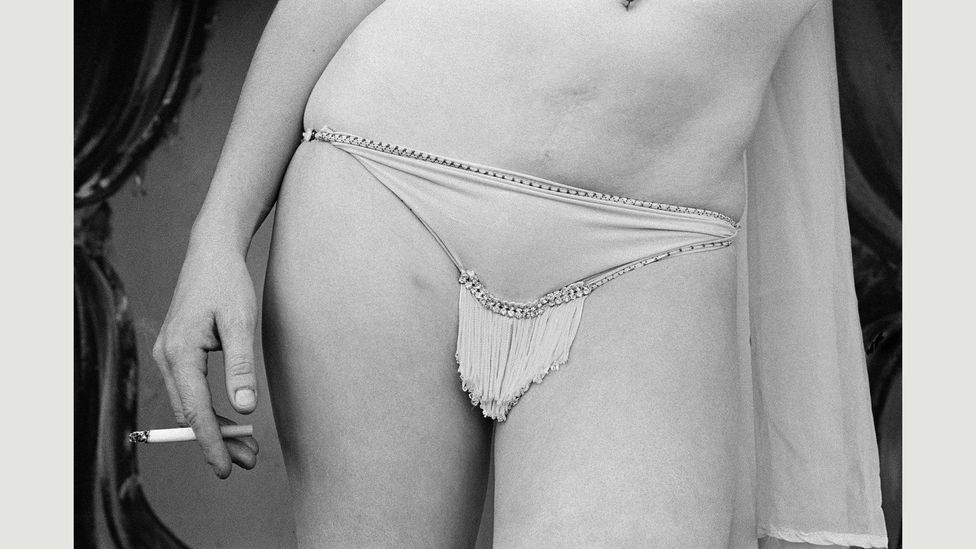
Susan Meiselas, Shortie on the Bally, Barton, Vermont, USA (Credit: Susan Meiselas / Magnum Photos)
"Back then, these issues were only just starting to filter into photography," says the curator, Clara Bouveresse. "But when you look at them today, you realise how topical and relevant they are now."
Private moments
When Meiselas and I speak, I ask her for her memories of the mid-70s, and how Carnival Strippers fitted into the debates of the time. She recalls that opting to turn her lens on women who stripped felt like a controversial act: some of her fellow feminists were appalled that she was attempting to document and understand this world rather than condemn it outright.
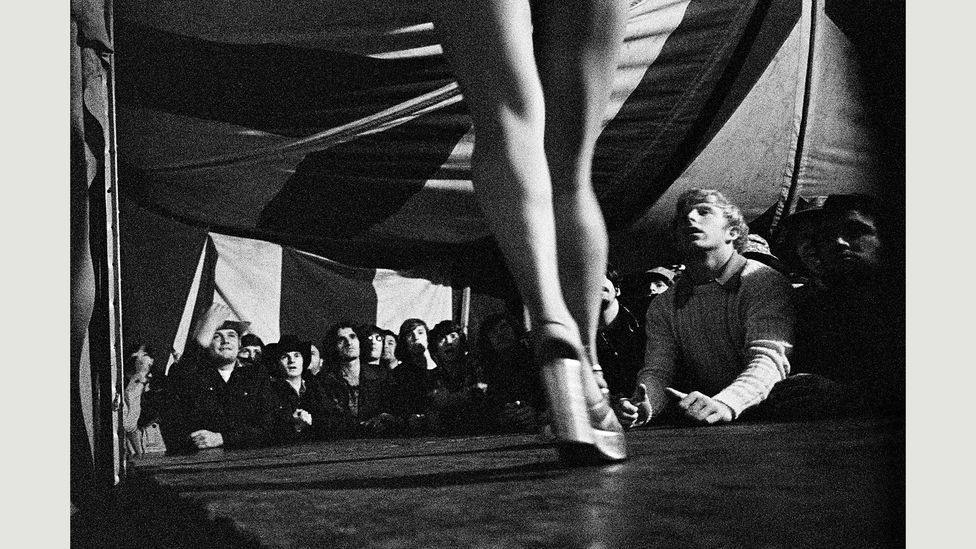
Susan Meiselas, Tunbridge, Vermont, USA, 1974 (Credit: Susan Meiselas / Magnum Photos)
"A lot of women regarded the girl shows as straightforwardly exploitative," she says. "That was the debate that was going on. But I wanted the book to be part of a dialogue. When one of the women I photographed, Lena, says she found performing a revolutionary experience, that for the first time she'd got men eating out of her hand, who could deny her that feeling? She was acting in defiance against what the world she'd grown up in expected her to be."
The pictures in Carnival Strippers are disarmingly intimate. We do see the dancers in their carefully crafted public roles, gyrating on makeshift stages in tasseled bikinis or posing for mobs of gawping, baying men. One particularly uncomfortable shot shows a woman in a semi-transparent twin piece perching on the 'bally box' outside the tent to drum up business, as if she's a prize animal on show.
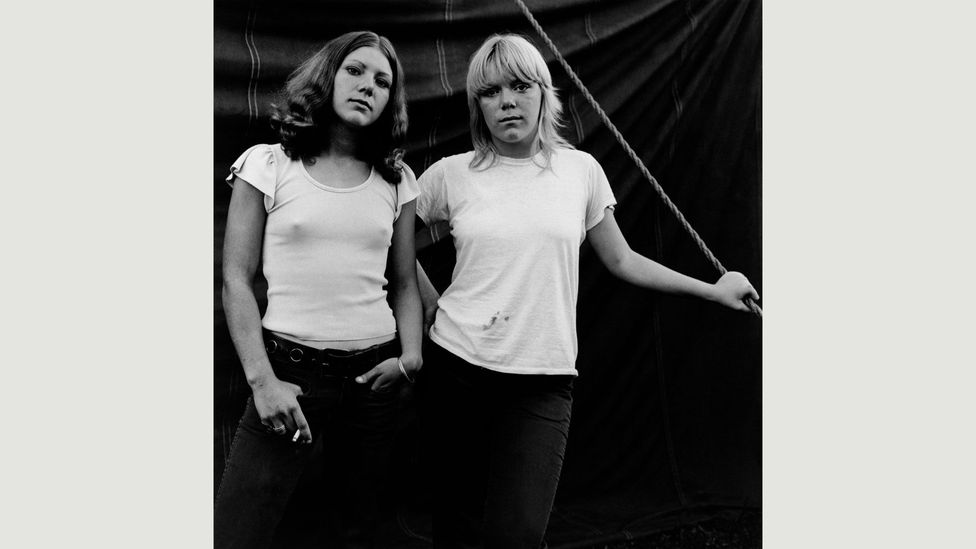
Susan Meiselas, Debbie and Renee, Rockland, Maine, USA, 1972 (Credit: Susan Meiselas / Magnum Photos)
But we also glimpse the strippers in private moments: lounging in dressing rooms playing cards; horsing around; swigging beer; collapsed on motel beds. For women who spend their lives on show, these times, captured by Meiselas in grainy, low-light photographs drenched in shadow and atmosphere, must have been particularly precious. In contrast to the bodies they put on display for paying customers, artfully costumed and made up, their real bodies – scarred, sweaty, dirty, sometimes bruised – are finally visible. It is a different and altogether more revealing kind of nakedness.
Bouveresse agrees: "There's an empowerment of sorts in these pictures: you see the variety of bodies, the flesh, the skin, the hair, the wrinkles, the scars."
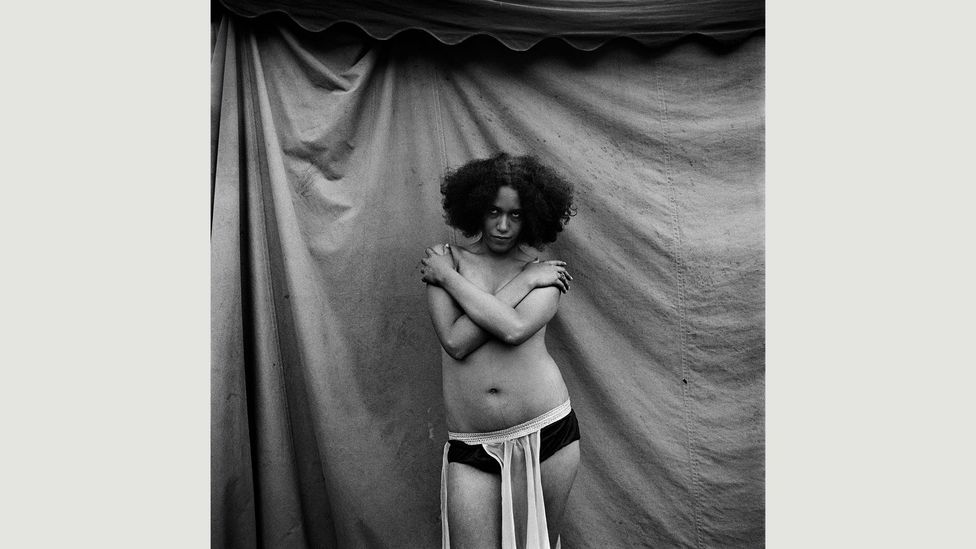
Susan Meiselas, New Girl, Tunbridge, Vermont, USA (Credit: Susan Meiselas / Magnum Photos)
Complexity is everywhere you look. A shot of Lena undercuts – or at least complicates – her words about revolution by depicting her after the show, naked and plainly exhausted, pressing a towel to her face in what looks like desperation. Yet elsewhere you sense something more defiant: a sense that these women are attempting to control how we look at them (Meiselas made sure to share her contact sheets with her subjects, often asking them to choose which pictures they liked). For all the tattiness of the fairs, what comes through is the sense of a close backstage community – solidarity, perhaps sisterhood.
Meiselas says, as a women watching these women, she felt it too. "I was like them and not like them," she says. "That's why the project was so interesting to me, in a way."
A democracy of looking
Eve Arnold's pictures are revealing in a different sense. Born in Philadelphia in 1912, Arnold shattered nearly every glass ceiling placed in her way: one of the first full members of the prestigious Magnum photo agency in the late 1950s, she managed to make a career as an independent photojournalist in an era when that trade was almost exclusively male (she once observed that "it's the frustration that drives you").
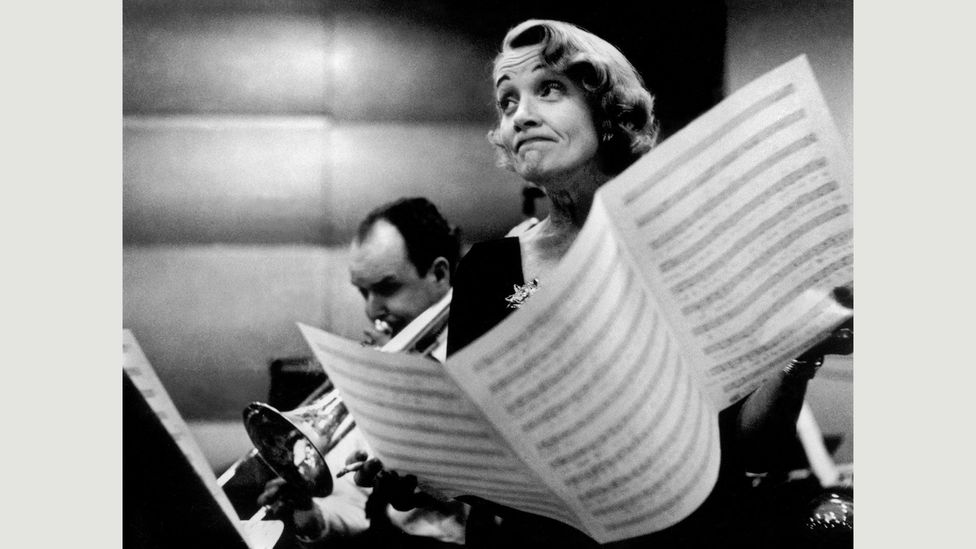
Eve Arnold, Marlene Dietrich at the Recording Studios of Columbia Records, New York, November 1952 (Credit: Eve Arnold / Magnum Photos)
A self-confessed workaholic, she had pictures printed in nearly every major photography publication of the 60s and 70s, among them the Sunday Times Magazine, Esquire, Harper's Bazaar, and Life magazine, and became especially renowned for candid shots of celebrities such as Joan Crawford, James Dean, Andy Warhol and Paul Newman. Despite the astonishing range of her work – South African townships in the apartheid era alongside confessional portraits of Marilyn Monroe, whom she shadowed for nearly a decade – she always had an eye for female subjects. In the early 1960s, she shot a pioneering photo essay on birth, and in 1971 made a film, Women Behind the Veil, which stepped inside the closeted world of Arab hammams and harems.
Even so, she waited until her 60s to produce The Unretouched Woman. "It was a way of looking back at her career as a photographer, saying who she was," says Bouveresse.
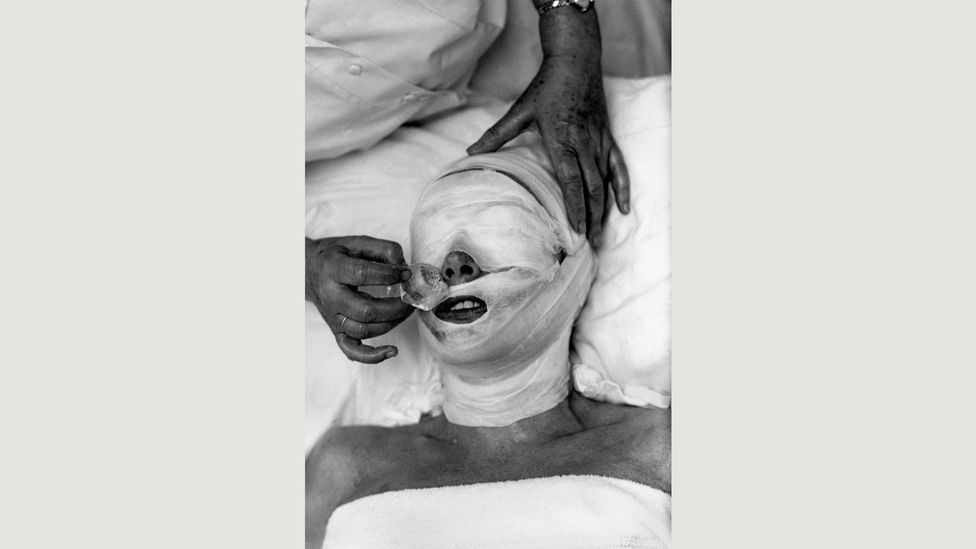
Eve Arnold, Actress Joan Crawford, Los Angeles, 1959 (Credit: Eve Arnold / Magnum Photos)
Though some of the images in the book feel a little uninvolved – pitch-perfect, pin-sharp pictures gathered by a globetrotting pro – they nonetheless speak to the democracy of Arnold's way of looking at the world, especially the women in it. Next to an image of pregnant Zulu women in a labour ward in South Africa there is a melancholy portrait of an elderly woman in a care home in the Cotswolds in England. Yes, here's Marilyn, probably the most photographed face of her era, but there are also women from Afghanistan, their own features obscured by flowing chadors.
Perhaps the most moving images in the Arles exhibition are those shot by Abigail Heyman. A neglected figure now, Heyman's attempt to capture female experience in Growing Up Female (subtitle: A Personal Photojournal) is more inward-looking than the other books: a living-out of the mantra that the personal is political. Combining unstaged, stripped-back photographs with handwritten comments, it echoes another canonical feminist text of the era, the bestselling study of female health and sexuality, Our Bodies, Ourselves. Where that book – which included guidance on everything from sexual orientation and gender identity to birth control – encouraged women to take control of their destiny, Heyman's images show us, again and again, how rarely women are portrayed in the media as they really are, even now.
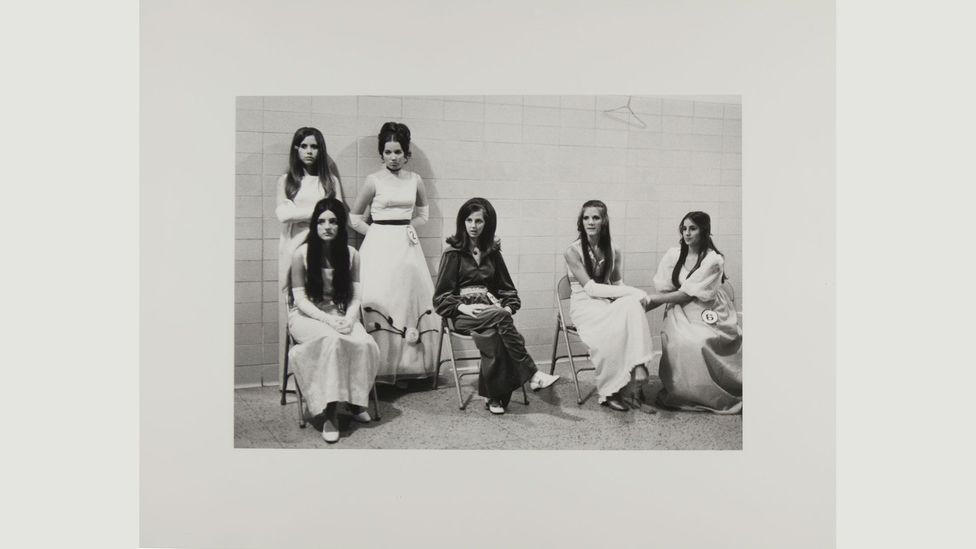
Abigail Heyman, Beauty Pageant, 1971 (Credit: Courtesy of Abigail Heyman)
As well as the simple beauty of these photographs – shot in a luminous black-and-white that, in Arles, seems to leap off the walls – they're full of sly irony. One of Heyman's photographs is a group shot of a beauty pageant in the Deep South of the US: six teenage girls, impeccably preened and perched on folding chairs, looking bored out of their skulls by the experience – as well they might. A picture taken at the Houston Livestock Fair in 1970 is a droll essay in gender expectations: three men in sober slacks and blazers clustered around a woman wearing a ten-gallon hat, knee-high boots and the shortest of shorts (one wonders what would have happened if the dress codes had been reversed).
Equally often, though, those expectations are turned on their head. A picture of schoolgirls in uniform tartan skirts catches one girl in pigtails separated from the rest of the pack: legs planted wide with a fearsome expression on her face, she stands defiantly alone, determined not to go along with the crowd.
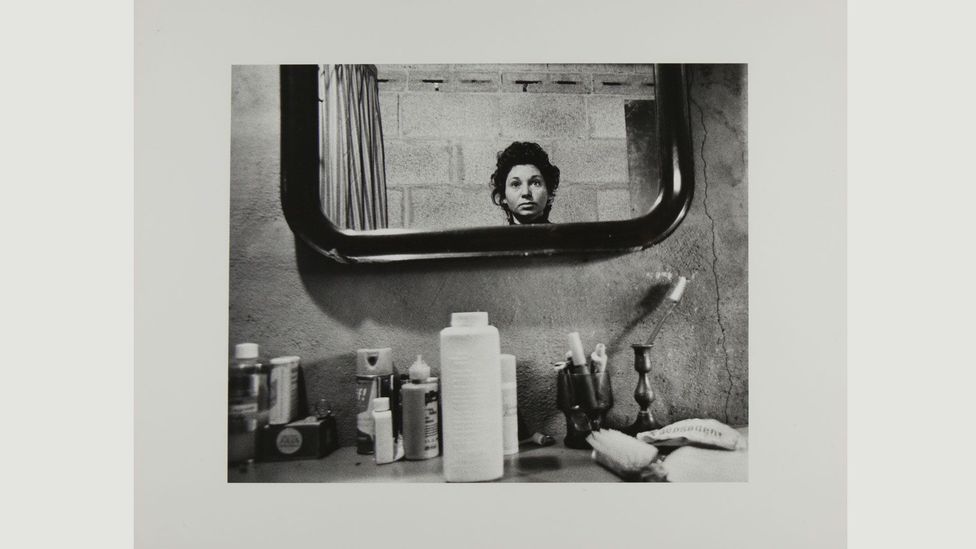
Abigail Heyman, Self-Portrait, 1971 (Credit: Courtesy of Abigail Heyman)
Somehow, it's the photographs Heyman took of herself – a feminist photographer's perspective on her own experience as a woman – that speak loudest to the exhibition's theme. One of her most reproduced images is of her own face caught in the bathroom mirror in an expression of surprise. Because of the angle she's taken the photograph from, her features are tiny, half cut-off by the mirror. Looming large at the bottom of the frame – far larger, in fact, than Heyman's head – are a clutter of beauty products, creams, gels and powders. Which is the more honest self-portrait, it seems to ask: my face, or the stuff I'm expected to put on it because of my gender? In the era of the #nomake-up selfie, it's a question we're asking still.
Unretouched Women is at the Rencontres d'Arles until 22 September.
If you would like to comment on this story or anything else you have seen on BBC Culture, head over to our Facebook page or message us onTwitter .
And if you liked this story, sign up for the weekly bbc.com features newsletter , called The Essential List. A handpicked selection of stories from BBC Future, Culture, Worklife and Travel, delivered to your inbox every Friday.
Source: https://www.bbc.com/culture/article/20190823-intimate-photos-of-womens-bodies
0 Response to "Mature Older Woman Cougar Poryrait Non Nude Fully Dressed"
Post a Comment